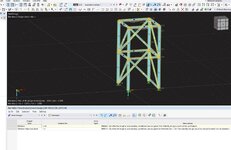Pretty Girl
Structural
Why these errors occur? This is a very basic structure to test the software. I did their steel hall tutorial as well before which it ran smoothly without any errors and at that the RFEM didn't ask to set effective lengths manually.
I just drew four legs, on top of the drew another four legs, connected those with beams and bracings and put hinged support. When I click the analyze button, it throws these errors.
Why don't it just automatically calculate the effective lengths etc. Or is it saying some other thing that I should have done?
Tension braces are also just steel beams (I just wanted to test it without wasting much time)

I just drew four legs, on top of the drew another four legs, connected those with beams and bracings and put hinged support. When I click the analyze button, it throws these errors.
Why don't it just automatically calculate the effective lengths etc. Or is it saying some other thing that I should have done?
Tension braces are also just steel beams (I just wanted to test it without wasting much time)

